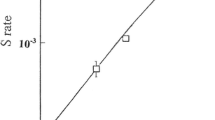Abstract
A clone of Chinese hamster ovary (CHO) cells, BT3,resistant to Tevenel, the sulfamoyl analog of chloramphenicol has been isolated. Resistance was found to be at the mitochondrial level and was shown to be cytoplasmically inherited. This marker was then used to develop a method by which a cell line possessing a dominant nuclear mutation (resistance to 5,6-dichloro-1-β-d-ribofuranosylbenzimidazole, DRB) could be used as a recipient in cybrid formation. The unique feature in this procedure was the removal of nucleated cells from the cytoplasts by passage through unipore filters. The dominant character of the DRB- and Tevenel-resistant phenotypes permitted the selection of cybrids immediately after fusion. This initially increased the frequency of cybrid clones 16-fold as compared to a recipient cell line possessing a recessive marker. The possibility of extending the method to recipient cells lacking a selectable drug-resistance marker is discussed.
Similar content being viewed by others
Literature cited
Spolsky, C.M., and Eisenstadt, J.M. (1972).FEBS Lett. 25:319–324.
Kislev, N., Spolsky, C.M., and Eisenstadt, J.M. (1973).J. Cell Biol. 57:571–579.
Mitchell, C.H., England, J.M., and Attardi, C. (1975).Somat. Cell Genet. 1:215–234.
Wallace, R.B., and Freeman, K.B. (1975).J. Cell Biol. 65:492–498.
Siegel, R.C., Jeffries, A.J., Sly, W.S., and Craig, J.W. (1976).Exp. Cell Res. 102:298–310.
Bunn, C.L., and Eisenstadt, J.M. (1977).Somat. Cell Genet. 3:611–627.
Lichtor, T., and Getz, G.S. (1978).Proc. Natl. Acad. Sci. U.S.A. 75:324–328.
Harris, M. (1978).Proc. Natl. Acad. Sci. U.S.A. 76:5604–5608.
Bunn, C.L., Wallace, D.C., and Eisenstadt, J.M. (1974).Proc. Natl. Acad. Sci. U.S.A. 71:1681–1685.
Wallace, D.C., Bunn, C.L., and Eisenstadt, J.M. (1975).J. Cell Biol. 67:174–188.
Mitchell, C.H., and Attardi, C. (1978).Somat. Cell Genet. 4:737–744.
Munro, E., Siegel, R.C., Craig, I.W., and Sly, W.S. (1978).Proc. R. Soc. London B201:73–85.
Gupta, R.S., and Siminovitch, L. (1978).Somat. Cell Genet. 4:77–93.
Grollman, A.P., and Jarkousky, Z. (1974). InAntibiotics, Vol. 4 (ed. Hahn, F., and Concoran, J.W. (Springer Verlag, New York), pp. 420–435.
Gupta, R.S., and Siminovitch, L. (1980).Somat. Cell Genet. 6:151–169.
Stanners, C.P., Eliceiri, G.L., and Green, H. (1971).Nature (London), New Biol. 230:52–54.
Puck, T.T., Marcus, P.I., and Ciecircua, S.J. (1956).J. Exp. Med. 103:273–284.
Stanley, P., Gaillibot, U., and Siminovitch, L. (1975).Somat. Cell Genet. 1:3–26.
Wigler, M.H., and Weinstein, I.B. (1975).Biochem. Biophys. Res. Commun. 63:669–674.
Fleischer, R.L., Price, P.B., and Symes, E.M. (1964).Science 143:249–250.
Norwood, T.H., Zeigler, C.J., and Marting, G.M. (1976).Somat. Cell Genet. 3:231–236.
Freeman, K.B. (1970).Can. J. Biochem. 48:469–478.
Fettes, I.M., Haldar, D., and Freeman, K.B. (1972).Can. J. Biochem. 50:200–209.
Walter, P., Lardy, H.A., and Johnson, D. (1957).J. Biol. Chem. 242:5014–5018.
Wilson, D.F. (1969).Biochemistry 8:2475–2480.
Bunn, C.L., Wallace, D.C., and Eisenstadt, J.M. (1977).Somat. Cell Genet. 3:71–92.
Baker, R.M., Brunette, D.M., Mankovitz, R., Thompson, L.H., Whitmore, G.F., Siminovitch, L., and Till, J.E. (1974).Cell 1:9–21.
Author information
Authors and Affiliations
Rights and permissions
About this article
Cite this article
Yatscoff, R.W., Mason, J.R., Patel, H.V. et al. Cybrid formation with recipient cell lines containing dominant phenotypes. Somat Cell Mol Genet 7, 1–9 (1981). https://doi.org/10.1007/BF01544744
Received:
Revised:
Issue Date:
DOI: https://doi.org/10.1007/BF01544744




